+ Open data
Open data
- Basic information
Basic information
| Entry | Database: PDB / ID: 6c2w | |||||||||
|---|---|---|---|---|---|---|---|---|---|---|
| Title | Crystal structure of human prothrombin mutant S101C/A470C | |||||||||
 Components Components | Prothrombin | |||||||||
 Keywords Keywords | BLOOD CLOTTING / Hydrolase / Kringle / enzyme mechanism / coagulation factor | |||||||||
| Function / homology |  Function and homology information Function and homology information: / thrombospondin receptor activity / Defective factor XII causes hereditary angioedema / thrombin / thrombin-activated receptor signaling pathway / negative regulation of astrocyte differentiation / regulation of blood coagulation / neutrophil-mediated killing of gram-negative bacterium / positive regulation of phospholipase C-activating G protein-coupled receptor signaling pathway / Defective F8 cleavage by thrombin ...: / thrombospondin receptor activity / Defective factor XII causes hereditary angioedema / thrombin / thrombin-activated receptor signaling pathway / negative regulation of astrocyte differentiation / regulation of blood coagulation / neutrophil-mediated killing of gram-negative bacterium / positive regulation of phospholipase C-activating G protein-coupled receptor signaling pathway / Defective F8 cleavage by thrombin / Platelet Aggregation (Plug Formation) / ligand-gated ion channel signaling pathway / positive regulation of collagen biosynthetic process / negative regulation of platelet activation / negative regulation of blood coagulation / positive regulation of blood coagulation / negative regulation of fibrinolysis / regulation of cytosolic calcium ion concentration / Transport of gamma-carboxylated protein precursors from the endoplasmic reticulum to the Golgi apparatus / Gamma-carboxylation of protein precursors / Common Pathway of Fibrin Clot Formation / Removal of aminoterminal propeptides from gamma-carboxylated proteins / fibrinolysis / Intrinsic Pathway of Fibrin Clot Formation / negative regulation of proteolysis / negative regulation of cytokine production involved in inflammatory response / Peptide ligand-binding receptors / Regulation of Complement cascade / positive regulation of release of sequestered calcium ion into cytosol / acute-phase response / Cell surface interactions at the vascular wall / positive regulation of receptor signaling pathway via JAK-STAT / growth factor activity / lipopolysaccharide binding / positive regulation of insulin secretion / platelet activation / response to wounding / positive regulation of protein localization to nucleus / Golgi lumen / Regulation of Insulin-like Growth Factor (IGF) transport and uptake by Insulin-like Growth Factor Binding Proteins (IGFBPs) / positive regulation of reactive oxygen species metabolic process / blood coagulation / antimicrobial humoral immune response mediated by antimicrobial peptide / regulation of cell shape / heparin binding / : / Thrombin signalling through proteinase activated receptors (PARs) / positive regulation of cell growth / blood microparticle / G alpha (q) signalling events / cell surface receptor signaling pathway / positive regulation of phosphatidylinositol 3-kinase/protein kinase B signal transduction / receptor ligand activity / endoplasmic reticulum lumen / signaling receptor binding / serine-type endopeptidase activity / positive regulation of cell population proliferation / calcium ion binding / proteolysis / extracellular space / extracellular exosome / extracellular region / plasma membrane Similarity search - Function | |||||||||
| Biological species |  Homo sapiens (human) Homo sapiens (human) | |||||||||
| Method |  X-RAY DIFFRACTION / X-RAY DIFFRACTION /  MOLECULAR REPLACEMENT / Resolution: 4.12 Å MOLECULAR REPLACEMENT / Resolution: 4.12 Å | |||||||||
 Authors Authors | Chinnaraj, M. / Chen, Z. / Pelc, L. / Grese, Z. / Bystranowska, D. / Di Cera, E. / Pozzi, N. | |||||||||
| Funding support |  United States, 1items United States, 1items
| |||||||||
 Citation Citation |  Journal: Sci Rep / Year: 2018 Journal: Sci Rep / Year: 2018Title: Structure of prothrombin in the closed form reveals new details on the mechanism of activation. Authors: Chinnaraj, M. / Chen, Z. / Pelc, L.A. / Grese, Z. / Bystranowska, D. / Di Cera, E. / Pozzi, N. #1:  Journal: J. Biol. Chem. / Year: 2016 Journal: J. Biol. Chem. / Year: 2016Title: How the Linker Connecting the Two Kringles Influences Activation and Conformational Plasticity of Prothrombin. Authors: Pozzi, N. / Chen, Z. / Di Cera, E. | |||||||||
| History |
|
- Structure visualization
Structure visualization
| Structure viewer | Molecule:  Molmil Molmil Jmol/JSmol Jmol/JSmol |
|---|
- Downloads & links
Downloads & links
- Download
Download
| PDBx/mmCIF format |  6c2w.cif.gz 6c2w.cif.gz | 245 KB | Display |  PDBx/mmCIF format PDBx/mmCIF format |
|---|---|---|---|---|
| PDB format |  pdb6c2w.ent.gz pdb6c2w.ent.gz | 195.9 KB | Display |  PDB format PDB format |
| PDBx/mmJSON format |  6c2w.json.gz 6c2w.json.gz | Tree view |  PDBx/mmJSON format PDBx/mmJSON format | |
| Others |  Other downloads Other downloads |
-Validation report
| Summary document |  6c2w_validation.pdf.gz 6c2w_validation.pdf.gz | 1 MB | Display |  wwPDB validaton report wwPDB validaton report |
|---|---|---|---|---|
| Full document |  6c2w_full_validation.pdf.gz 6c2w_full_validation.pdf.gz | 1 MB | Display | |
| Data in XML |  6c2w_validation.xml.gz 6c2w_validation.xml.gz | 42.3 KB | Display | |
| Data in CIF |  6c2w_validation.cif.gz 6c2w_validation.cif.gz | 55.7 KB | Display | |
| Arichive directory |  https://data.pdbj.org/pub/pdb/validation_reports/c2/6c2w https://data.pdbj.org/pub/pdb/validation_reports/c2/6c2w ftp://data.pdbj.org/pub/pdb/validation_reports/c2/6c2w ftp://data.pdbj.org/pub/pdb/validation_reports/c2/6c2w | HTTPS FTP |
-Related structure data
| Related structure data | 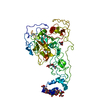 6bjrC 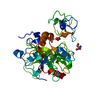 3nxpS 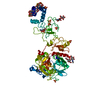 5edmS S: Starting model for refinement C: citing same article ( |
|---|---|
| Similar structure data |
- Links
Links
- Assembly
Assembly
| Deposited unit | 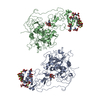
| ||||||||
|---|---|---|---|---|---|---|---|---|---|
| 1 | 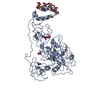
| ||||||||
| 2 | 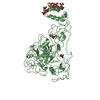
| ||||||||
| Unit cell |
|
- Components
Components
| #1: Protein | Mass: 66309.875 Da / Num. of mol.: 2 / Mutation: S101C, A470C Source method: isolated from a genetically manipulated source Source: (gene. exp.)  Homo sapiens (human) / Gene: F2 / Cell line (production host): Baby Hamster Kidney / Production host: Homo sapiens (human) / Gene: F2 / Cell line (production host): Baby Hamster Kidney / Production host:  Mesocricetus auratus (golden hamster) / References: UniProt: P00734, thrombin Mesocricetus auratus (golden hamster) / References: UniProt: P00734, thrombin#2: Polysaccharide | Source method: isolated from a genetically manipulated source #3: Chemical | ChemComp-MG / #4: Sugar | |
|---|
-Experimental details
-Experiment
| Experiment | Method:  X-RAY DIFFRACTION / Number of used crystals: 1 X-RAY DIFFRACTION / Number of used crystals: 1 |
|---|
- Sample preparation
Sample preparation
| Crystal grow | Temperature: 277 K / Method: vapor diffusion / pH: 9 / Details: 100 mM Bicine, pH 9.0 and 11% PEG 3350 |
|---|
-Data collection
| Diffraction | Mean temperature: 100 K | |||||||||||||||||||||||||
|---|---|---|---|---|---|---|---|---|---|---|---|---|---|---|---|---|---|---|---|---|---|---|---|---|---|---|
| Diffraction source | Source:  ROTATING ANODE / Type: RIGAKU MICROMAX-007 HF / Wavelength: 1.5418 Å ROTATING ANODE / Type: RIGAKU MICROMAX-007 HF / Wavelength: 1.5418 Å | |||||||||||||||||||||||||
| Detector | Type: RIGAKU RAXIS IV++ / Detector: IMAGE PLATE / Date: Nov 17, 2017 | |||||||||||||||||||||||||
| Radiation | Monochromator: Mirror / Protocol: SINGLE WAVELENGTH / Monochromatic (M) / Laue (L): M / Scattering type: x-ray | |||||||||||||||||||||||||
| Radiation wavelength | Wavelength: 1.5418 Å / Relative weight: 1 | |||||||||||||||||||||||||
| Reflection twin |
| |||||||||||||||||||||||||
| Reflection | Resolution: 4.1→40 Å / Num. obs: 30018 / % possible obs: 91.7 % / Observed criterion σ(F): -1 / Observed criterion σ(I): -1 / Redundancy: 2.5 % / Rmerge(I) obs: 0.156 / Net I/σ(I): 5.7 | |||||||||||||||||||||||||
| Reflection shell | Resolution: 4.1→4.17 Å / Redundancy: 1.8 % / Rmerge(I) obs: 0.675 / Num. unique obs: 1219 / % possible all: 74.1 |
- Processing
Processing
| Software |
| ||||||||||||||||||||||||||||||||||||||||||||||||||||||||||||||||||||||||||||||||||||||||||||||||||||||||||||||||||||||||||||||||||||||||||||||||||||||||||||||||||||||||||||||||||||||
|---|---|---|---|---|---|---|---|---|---|---|---|---|---|---|---|---|---|---|---|---|---|---|---|---|---|---|---|---|---|---|---|---|---|---|---|---|---|---|---|---|---|---|---|---|---|---|---|---|---|---|---|---|---|---|---|---|---|---|---|---|---|---|---|---|---|---|---|---|---|---|---|---|---|---|---|---|---|---|---|---|---|---|---|---|---|---|---|---|---|---|---|---|---|---|---|---|---|---|---|---|---|---|---|---|---|---|---|---|---|---|---|---|---|---|---|---|---|---|---|---|---|---|---|---|---|---|---|---|---|---|---|---|---|---|---|---|---|---|---|---|---|---|---|---|---|---|---|---|---|---|---|---|---|---|---|---|---|---|---|---|---|---|---|---|---|---|---|---|---|---|---|---|---|---|---|---|---|---|---|---|---|---|---|
| Refinement | Method to determine structure:  MOLECULAR REPLACEMENT MOLECULAR REPLACEMENTStarting model: 5EDM and 3NXP Resolution: 4.12→30.32 Å / Cor.coef. Fo:Fc: 0.827 / Cor.coef. Fo:Fc free: 0.74 / SU B: 19.344 / SU ML: 0.291 / Cross valid method: THROUGHOUT / ESU R Free: 0.181 / Stereochemistry target values: MAXIMUM LIKELIHOOD / Details: HYDROGENS HAVE BEEN ADDED IN THE RIDING POSITIONS
| ||||||||||||||||||||||||||||||||||||||||||||||||||||||||||||||||||||||||||||||||||||||||||||||||||||||||||||||||||||||||||||||||||||||||||||||||||||||||||||||||||||||||||||||||||||||
| Solvent computation | Ion probe radii: 0.8 Å / Shrinkage radii: 0.8 Å / VDW probe radii: 1.2 Å / Solvent model: MASK | ||||||||||||||||||||||||||||||||||||||||||||||||||||||||||||||||||||||||||||||||||||||||||||||||||||||||||||||||||||||||||||||||||||||||||||||||||||||||||||||||||||||||||||||||||||||
| Displacement parameters | Biso mean: 191.324 Å2
| ||||||||||||||||||||||||||||||||||||||||||||||||||||||||||||||||||||||||||||||||||||||||||||||||||||||||||||||||||||||||||||||||||||||||||||||||||||||||||||||||||||||||||||||||||||||
| Refinement step | Cycle: 1 / Resolution: 4.12→30.32 Å
| ||||||||||||||||||||||||||||||||||||||||||||||||||||||||||||||||||||||||||||||||||||||||||||||||||||||||||||||||||||||||||||||||||||||||||||||||||||||||||||||||||||||||||||||||||||||
| Refine LS restraints |
|
 Movie
Movie Controller
Controller





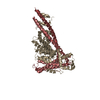

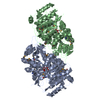
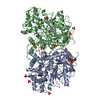


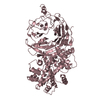
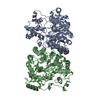
 PDBj
PDBj











